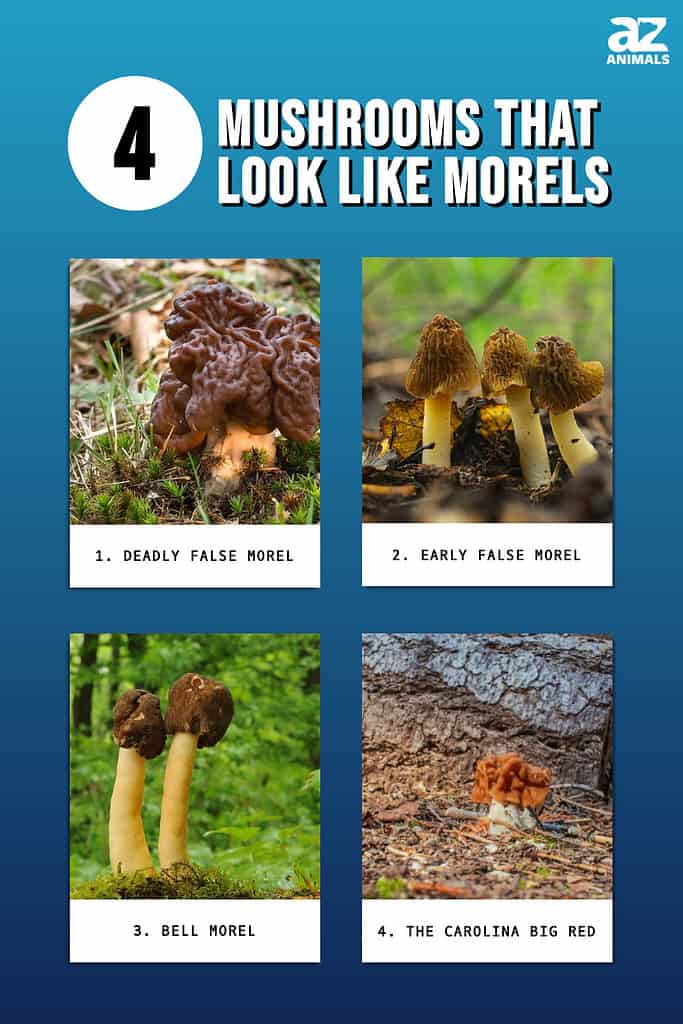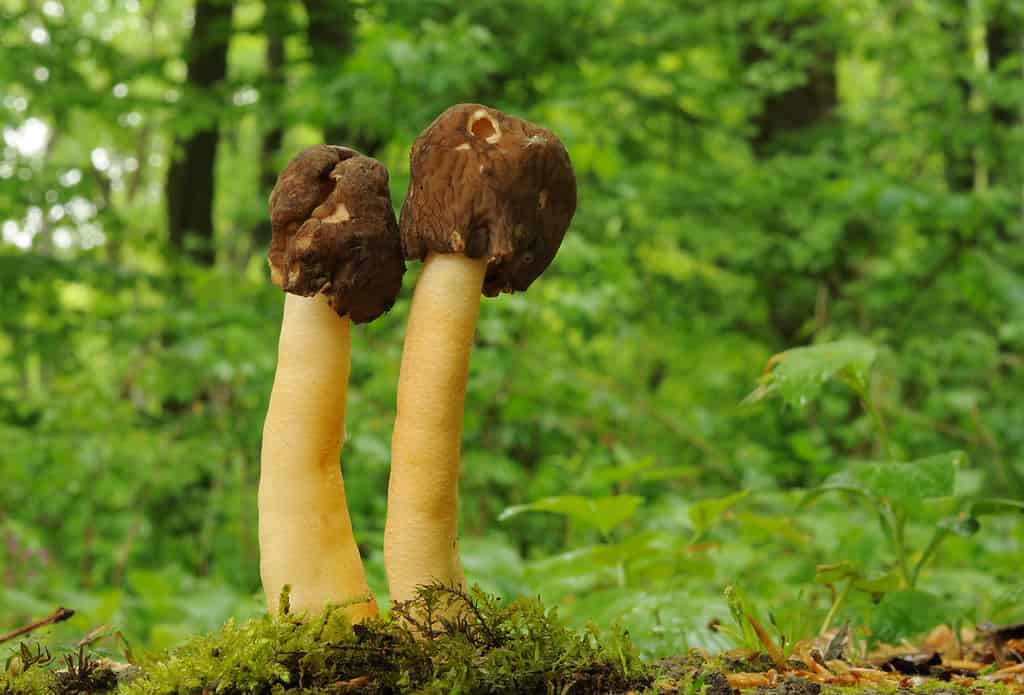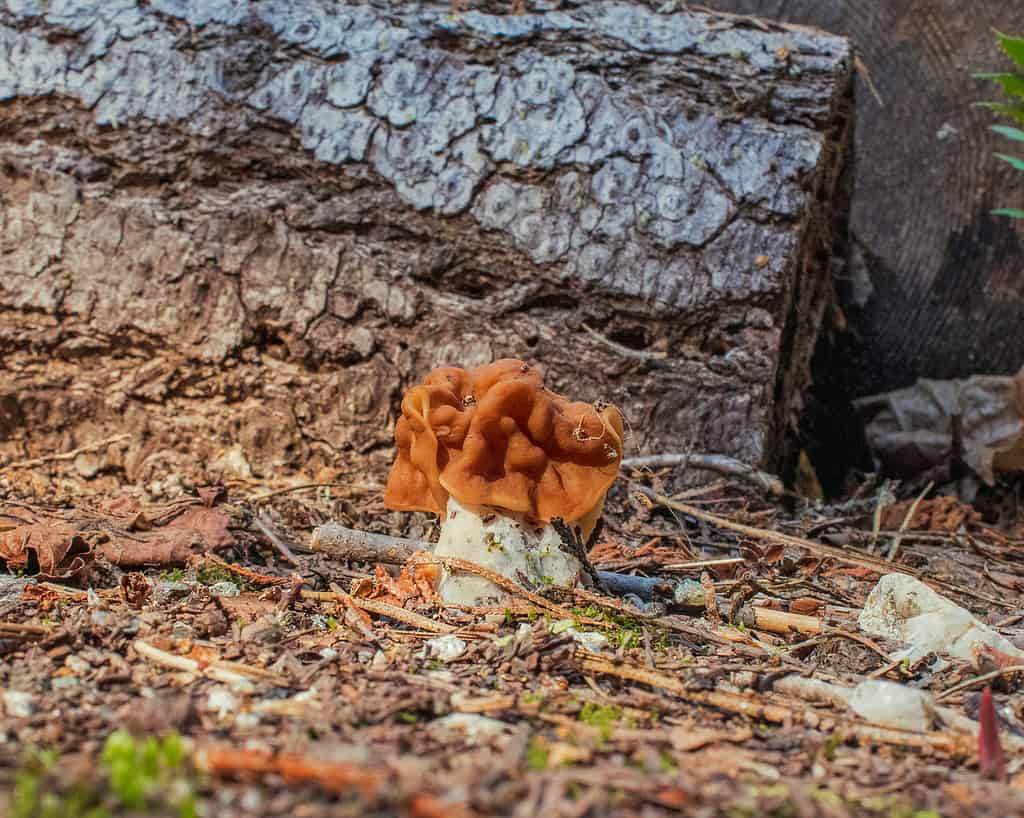As edible mushroom lovers and chefs worldwide can attest, morels (Morchella spp.) aren’t overhyped. They’re not just sought-after because of their exotic looks—they are highly prized edibles in many parts of the world.
But regrettably, morels are elusive. Because these mushrooms only grow in the wild, the easiest way to enjoy a plate is to forage for them in the woods. Recognizing them is usually straightforward. However, for the inexperienced eye, it can be a tall order due to the presence of morel look-alikes. To make things simple, many know them as false morels.
This article reviews four mushrooms that look like morels, providing valuable details about what they are and how to spot them when hunting for true morels. We’ll also offer strategies to track and store the latter for weeks or months. Let’s get down to it!

What Are Morel Look-Alikes?
False morels are mushroom species resembling true morels. True morels belong to the genus Morchella. Some of these false morels are poisonous. They contain the toxin gyromitrin, which can metabolize into monomethylhydrazine (MMH), often used as rocket fuel.
Unbelievably, some people have mastered the art of preparing morel look-alikes to consume them without experiencing severe symptoms. But the odds don’t favor everyone.
For instance, in 2016, in Kalamazoo, MI, three people fell ill after unknowingly eating morel look-alikes thinking they were true morels. That’s why it’s paramount to learn the distinguishing features of these Wanna-Be morels. False morel characteristics include:
- Caps that are loosely attached to the stems and easily fall off with a slight twist
- Distorted, wavy, or lobed caps without ridges
- Chunks of tissue or solid matter inside
- Round, wide caps that resemble a brain
- Stems that run to the top of the caps
- Occasional orange or dark red coloration
1. Deadly False Morel (Gyromitra esculenta)

Because
Gyromitra esculentalooks so much like a brain, people refer to it as the brain mushroom.
©FotoLot/Shutterstock.com
The Gyromitra esculenta, also known as “beefsteak”, can be mistaken for the Morchella species. This morel look-alike features a reddish-brown or yellow coloration with an irregularly lobed cap.
Because it looks so much like a brain, some people refer to it as the brain mushroom. If you cut it lengthwise, you’ll find air chambers between the top of the stem and the surface of its typically 2-7 cm broad head.
Gyromitra esculenta is among the deadliest types of morel look-alikes. Cooking it is inadvisable, but if you must, be sure to use an open vessel to allow the poisonous fumes to escape. If you’re a newbie, get an expert to guide you on drying and boiling it. Ideally, boil it at least twice, and pour the water each time.
Where to Find the Gyromitra Esculenta
This false morel mainly grows beneath pine trees and conifers in the spring and early summer. You may also spot it under some hardwoods in various parts of Europe and the USA. Be wary of a lot of info you will find on this genus online, as there are a lot of mistakes and old wives tales.
2. Early False Morel (Verpa bohemica)

The early false morel’s stem is longer than its cap.
©Rastkobelic/Shutterstock.com
Also known as the wrinkled thimble-cap, Verpa bohemica is another mushroom species that people mistake for morels. They bear a close resemblance to true morels and are edible when cooked.
It’s a member of the family Morchellaceae and has a bell-shaped or conical cap with brain-like folds. Its color ranges from brown to dark yellow-brown, tan, and pale yellow. The stem is thin and long, with a cream-beige color.
One of the fastest ways to distinguish between Verpa bohemica and a true morel is by measuring or looking at the stems and cap lengths. The early false morel’s stem is longer than its cap. Conversely, true morels’ stems and caps are the same size. Although Verpa bohemica and the previously discussed Gyromitra esculenta both have hollow stems and brain-like caps, the latter is much more toxic.
Where to Find the Verpa Bohemica
Verpa bohemica has many habitats, including North American, European, and Asian woodlands. They thrive in areas with temperatures of between 55 °F and 60 °F, and you’ll likely find them under conifer and deciduous trees.
They also grow in ravines and at the edges of ponds in the spring, a few weeks before the real morels appear. But the exact time depends on your location. For instance, these morel look-alikes turn up in early May in Alberta.
3. Bell Morel (Verpa conica)

Its most distinguishing characteristic is a smoother cap that looks like a thimble freely hanging from the stem.
©Tomasz Czadowski/Shutterstock.com
Also known as the early morel or the thimble fungus, Verpa conica belongs to the family Morchellaceae and is the cousin to another morel look-alike, the Verpa bohemica. Its most distinguishing characteristic is a smoother cap compared to similar mushrooms that looks like a thimble freely hanging from the stem. The underside is dark brown or tan, while the stem is whitish.
The bell morel’s stem is sometimes equal to the base in width, but it can also be a bit thicker depending on the specimen. While it’s smooth in some, it’s velvety in others. Inside, the false morel is typically hollow, although young fungi have cotton-like hyphae.
Like the Verpa bohemica, the Verpa conica is edible when cooked. However, don’t throw all caution out the window, especially when preparing it. The mushroom is still toxic raw and may cause GI distress.
Where to Find the Verpa Conica
The habitats of Verpa conica vary across North America. It’s primarily found in coniferous and hardwood forests near stream banks and river valleys. Typically, the mushroom fruits in spring as the morel season approaches.
Uses of Verpa conica
Despite being toxic raw, some people enjoy this mushroom as much as they do morels. Though eating the morel look-alike isn’t highly recommended, some people claim that it may have some medicinal properties. In addition, the fungi have a high iron binding capacity, which may be handy during peroxidation protection.
4. The Carolina Big Red (Gyromitra caroliniana)

The Carolina false morel has a highly wrinkled red-brown cap with a smooth, bald texture, usually darker in weather-beaten specimens.
©AlexBless/Shutterstock.com
The Gyromitra caroliniana, also known as the Carolina false morel, is another mushroom species new foragers might think is a true morel. There are several characteristics to watch out for when distinguishing this ascomycete fungus from others.
First, it has a highly wrinkled red-brown cap with a smooth, bald texture, usually darker in weather-beaten specimens. Contrary to many morel look-alikes, it’s tightly attached to the stem, so only a tiny part of the head hangs over.
Cutting open the Gyromitra caroliniana reveals a chambered interior resembling a tree. You’ll also see whitish delicate flesh forms that differentiate it from true morels, whose insides are always hollow. The big red resembles several other species in the same genus, including:
- Gyromitra brunnea
- Gyromitra esculenta
- Gyromitra korfii
- Gyromitra fastigiata
Where to find the Gyromitra caroliniana
The big red only grows in the U.S. in states such as Ohio, Mississippi, Kansas, and Oklahoma. Typically, this species lives near dead wood and along river bottoms. It fruits in the southern states in March, but you might have to wait until April or May to see it elsewhere. Nevertheless, it signifies the beginning of the awaited morel season, prompting mushroom lovers to prepare for hunting.
Is Gyromitra caroliniana Edible?
This Gyromitra species doesn’t have the same toxic compounds as Gyromitra esculenta or at least not in large enough quantities to cause the same issues from consumption. The Carolina false morel is considered edible when cooked. The methods of proper boiling and drying aren’t necessary to ‘detoxify’ this morel look-alike and make it safe for eating. All that said, if you can’t ID it to species, don’t eat it as there are many similar looking species to the untrained eye.
Tips On Collecting Morel Mushrooms
With knowledge about mushrooms that look like morels and how to tell these fungi apart, it should be easy to find true morels in the wild. But how can you find as many as possible? Start by leveraging these valuable tips:
Get The Timing Right
Figuring the best time to forage for morels is critical. Typically, these edible mushrooms fruit between late March and mid-June, but it depends on your location and the species. For instance, the morel hunting season peaks in May in Michigan, but sightings further south are much earlier.
In many states, the most suitable time to collect morels is in the spring. But of course, you must factor in the weather before going out in the woods. These fungi like moist, cool climates and will likely pop up following several spring rainstorms. It’s advisable to wait until later in the season to land larger morels up to 5 inches tall.
Choose The Right Location
You can explore many places to find mushrooms. These delectable, nutritious fungi live almost everywhere, from logging sites and mossy areas to pine forests, hillsides, and grazing lands. With the right timing and location, you can collect many of them to enjoy with your family and friends. Do your homework to know the specific environments to scout for morels.
For instance, if you live near a forest or park, look around trees like oak, aspen, pine, conifers, and ash. Check out dying or dead trees, too—mushrooms usually pop up around the base. Additionally, explore creek banks; you could get lucky and find a morel patch!
Seek Help
Most veterans can easily find morels when hunting alone. But if you’re a new forayer, these fungi can elude for multiple seasons, explaining why seeking help is a great idea. In most cases, the best move is to reach out to an experienced mushroom hunter and even accompany them on several hunting trips.
Another way to find help is to take advantage of online resources – countless blogs and YouTubers offer tips for beginner morel hunters, but of course, know your source. You could find helpful pointers if you’re specific with your searches, providing the locations you want to explore and the species you hope to collect.
Bring Reference Pictures
New foragers often have difficulty collecting morels because they can’t remember a specific species’ appearance. Either bring a field guide or download some pictures on your smartphone and use them to identify the species you find in nature. The websites https://mushroomobserver.org/ and https://www.inaturalist.org/ have many peer reviewed examples. These photos should include morel look-alikes (make sure you have them labelled on your phone) to help you avoid the tricky mushrooms.
Prepare Adequately
As the most successful morel foragers will tell you, preparation is critical. Like any other hunters, purchase the right gear to make your experience safer, more comfortable, and effortless. Examples of these necessary items are:
- Comfy hiking boots
- Long pants
- Hiking sticks
- Morel collection bags
- A sharp pocketknife or a small garden pruner
- Insect repellents
- Always check for ticks afterwards
Be Patient
As an inexperienced mushroom forager, it’s easy to become discouraged if you don’t land any morels during your first few trips into the wild. But remember, these fungi are camouflaged, and it might take a while to develop an eye for them. Be patient and hunt hard. As you amass more experience, it should be easier to spot true morels and you will eventually have your own spots that produce yearly.
How To Preserve Morel Mushrooms
Let’s say you’re lucky enough to find a heap of morels during your hunting trip. You can’t possibly finish them all in a day, right? Therefore, preserving these delicacies through drying is advisable. Thankfully, there are several ways to do that, such as:
Dehydration
Use a tray dehydrator to preserve your morel mushrooms. Removing all the moisture so they’re dehydrated prevents bacterial growth to ensure they’re safe for consumption for months.
Once the morels are cracker dry, keep them in an air-tight container in your kitchen cabinet. Don’t store them in your fridge because they will rot.
If you lack a dehydrator, dry your morels in your oven. First, preheat as low as you can go, up to 170 degrees. Then, arrange the morel mushrooms in one later on a baking sheet and bake for one hour. Flip the morels and continue cooking until they’re crisp.
Leverage The Sun
Use the sun if you don’t want to go through the hassle of drying morels using a dehydrator or oven. Lay them on a screen or rack and dry them in the sun. This method also enables them to retain their original shape. But for it to be effective, you need many hours of warm sun when it’s not high humidity outside, meaning you have to pick your days strategically. Store the mushrooms in an air-tight jar once they’re totally dry. They’ll still be flavorsome when cooked, although fresh ones taste better.
Don’t Let Morel Look-Alikes Fool You
Now that you know about mushrooms that look like morels, keep your eyes peeled for them when foraging for true morels. The latter is the rockstar on the food stage with its nutty, earthy taste and meaty texture. Whether fried, sautéed, simmered, or baked, they are satisfying yummy treats. Feel free to pair them with pasta, beef, bacon, eggs, or asparagus, and remember to douse them with a bit of white or red wine to enhance their taste.
At the same time, remember that some people still harvest and consume toxic morel look-alikes, such as Gyromitra esculenta. Unless they’re dried and appropriately boiled, they can kill you. And even if you’re lucky, you’ll get symptoms like bloating, fatigue, headache, dizziness, muscle cramps, nausea, and diarrhea. Hence, it’s best to steer clear of them if you have little experience in preparing and cooking wild mushrooms.
The photo featured at the top of this post is © iStock.com/TT
The information presented on or through the Website is made available solely for general informational purposes. We do not warrant the accuracy, completeness, or usefulness of this information. Any reliance you place on such information is strictly at your own risk. We disclaim all liability and responsibility arising from any reliance placed on such materials by you or any other visitor to the Website, or by anyone who may be informed of any of its contents. None of the statements or claims on the Website should be taken as medical advice, health advice, or as confirmation that a plant, fungus, or other item is safe for consumption or will provide any health benefits. Anyone considering the health benefits of particular plant, fungus, or other item should first consult with a doctor or other medical professional. The statements made within this Website have not been evaluated by the Food and Drug Administration. These statements are not intended to diagnose, treat, cure or prevent any disease.
Thank you for reading! Have some feedback for us? Contact the AZ Animals editorial team.







